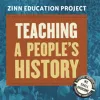Take a look inside 4 images
Zinn Education Project
Pros: The lessons address a complex view of history, emphasizing the significant roles of the working class, women, and people of color.
Cons: Many of the text-based lessons would need to be adapted to offer access to English Language Learners and struggling readers.
Bottom Line: Free downloadable resources encourage critical thinking and active learning in search of a more accurate picture of American history.
First and foremost, U.S. history teachers will probably want to bookmark the site. The lessons available will help add depth to any traditional history lesson. The best way to use these materials is to integrate any relevant teaching activities throughout the year. As students participate in multiple lessons, they'll have time to digest Zinn’s approach to the study of history.
When studying the Civil War, students can become members of an Anti-Slavery Society to learn about abolition; or in a unit on Vietnam, students can examine documents that are often left out of textbooks to get a more accurate picture of the war. Access to a text copy of A People’s History is recommended for both teachers and students -- though it's not required to use the site's materials, many lessons reference or use excerpts from the book.
The goal of the Zinn Education Project is to bring the ideas of Howard Zinn’s well-known book, A People’s History of the United States, into the classroom to foster a more honest and critical view of American history. Mainly a resource for teachers, the site has more than 100 classroom-tested, free downloadable lessons. For the most part, these move students away from the memorization of dates and facts and toward a more complex understanding of history, including the choices and circumstances that have contributed to various events. The ability to search by theme, time period, or resource type helps teachers find specific resources to supplement their curriculum.
Overall, the site's materials pay special attention to the inclusion of multiple perspectives, recognizing the roles of women, people of color, and the working class throughout history. Teachers can search for lessons by theme, time period, or resource type. In addition to the extensive collection of lessons, there are references to books, films, and articles (available for purchase online) on all of the topics to provide supplementary content.
While the Zinn Education Project is aimed mostly at teachers, it could also serve as a resource for older or more advanced students. The site is well-designed and engaging enough to support high school students' own exploration and research. No matter how they're used, the materials challenge students to go beyond the textbook and uncover the role of regular individuals throughout American history.
Instructional strategies include role-playing activities and simulations that actively engage students in their learning. Highlights of the collection include "People vs. Columbus, et al," a role play in which students participate in a trial; the "Draft Riot Mystery," in which students solve a mystery using historical clues; and "Whose Terrorism?" in which students examine scenarios based on real situations. While every activity lists a reading level, teachers may need to adapt some of the content to be more accessible for English Language Learners or struggling readers. Also, more in the way of interactive, digital activities aimed directly at students would be a nice complement to the site's wealth of downloadable teacher resources.












